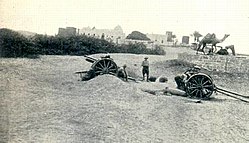South Arabia during World War I
| Campaign in South Arabia | |||||||
|---|---|---|---|---|---|---|---|
| Part of Middle Eastern theatre of World War I | |||||||
 A QF 15 pounder emplacement of B Battery, Honourable Artillery Company at Sheik Othman in 1915 |
|||||||
|
|||||||
| Belligerents | |||||||
|
|
|
||||||
| Commanders and leaders | |||||||
|
Ahmed Tevfik Pasha (Commander of the VII Corps) Ali Sait Pasha (Taiz Operational Region) Hüseyin Ragıp Bey (Tehame Operational Region) |
H. V. Cox Fadhl ibn Ali al Abdali (Lahij) Sharif Hussein (Hejaz) |
||||||
| Strength | |||||||
| ? |
|
||||||
| Casualties and losses | |||||||
| ? |
647 killed/missing 584+ wounded 32 captured |
||||||
Stalemate
H. V. Cox
(Commander of the 29th Indian Brigade)
D. G. L. Shaw
(Commander of the Aden Brigade)
George J. Younghusband
(Commander of the Aden Brigade)
Percival Hill-Thompson
(Captain of HMS Philomel)
The campaign in South Arabia during World War I was a minor struggle for control of the port city of Aden, an important way station for ships on their way from Asia to the Suez Canal. The British Empire declared war on the Ottoman Empire on 5 November 1914, and the Ottomans responded with their own declaration on 11 November. From the beginning, the Ottomans had planned an invasion of Britain's Aden Protectorate in cooperation with the local Arab tribes. The Ottomans had gathered in some strength on the Cheikh Saïd, a peninsula which juts out into the Red Sea towards the island of Perim.
...
Wikipedia
